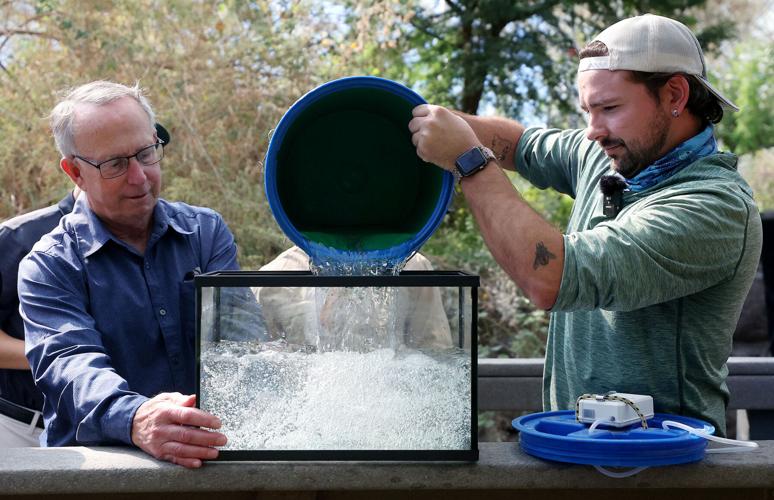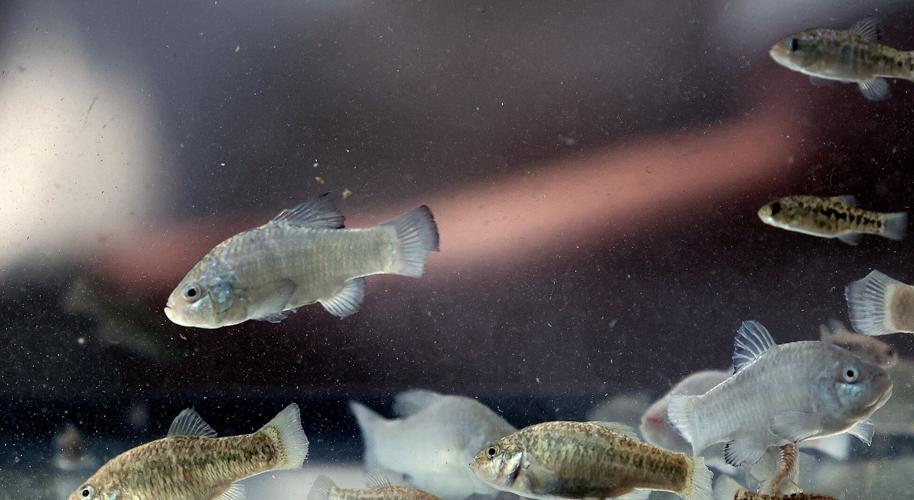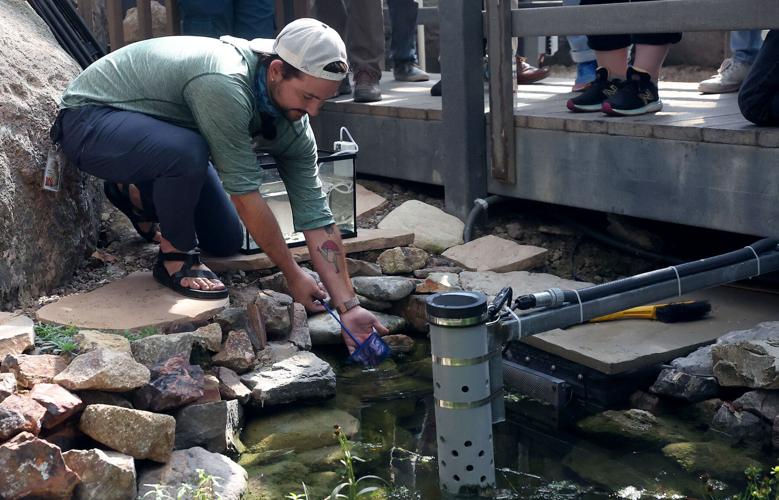After decades spent clinging to existence in a single, spring-fed oasis in southwestern Pima County, the endangered Sonoyta pupfish is giving indoor living a try.
Four dozen of the feisty little desert fish were released on Friday into an artificial spring pool built especially for them inside the glass pyramid at the University of ArizonaŌĆÖs in Oracle.
With an enthusiastic crowd of about 50 people looking on, the 48 fish seemed to take to their new habitat right away.
ŌĆ£You can see the males are already starting to fight,ŌĆØ said , an adjunct associate professor with the U of AŌĆÖs Department of Ecology and Evolutionary Biology. ŌĆ£That means theyŌĆÖre happy. TheyŌĆÖre already establishing territories.ŌĆØ
People are also reading…
Sonoyta pupfish are about the size of a pinkie finger, with bulky bodies, upturned mouths and a sometimes-aggressive demeanor.
ŌĆ£I always think of them as little bulldogs in the water,ŌĆØ said Brett Montgomery, topminnow and pupfish specialist with the Arizona Game and Fish Department.
The males sport a flashy, metallic blue color that grows brighter during mating season. The females come in a dusky green or brown, with vertical bars or stripes.

Forty-eight Sonoyta pupfish were placed into a tank before they were released Friday into an artificial stream in the University of ArizonaŌĆÖs Biosphere 2.┬Ā
The only place the species can still be found in the wild is at Quitobaquito Springs, just north of the U.S.-Mexico border in Organ Pipe Cactus National Monument, which explains why itŌĆÖs also commonly referred to as the .
The speciesŌĆÖ historic range includes the Rio Sonoyta south of the border, but the river has mostly run dry as a result of groundwater depletion and deepening aridification. ŌĆ£No fish have been observed there in years,ŌĆØ Montgomery said.
To stave off extinction, backup supplies of pupfish have been established at seven different locations throughout Arizona, including this newest one.
Moving indoors
The Game and Fish Department, Biosphere 2 and the U.S. Fish and Wildlife Service collaborated on FridayŌĆÖs release as part of a designed to make it easier ŌĆö and less legally perilous ŌĆö to establish reserve habitats for endangered species in places not under federal government control.
ŌĆ£Ultimately, weŌĆÖd like to create more refuge populations (of pupfish), just in case something catastrophic happens to Quitobaquito,ŌĆØ Montgomery said.
The BiosphereŌĆÖs rare new residents arrived in a five-gallon plastic water jug, after Montgomery collected them from a reserve population at a private residence in Phoenix. ŌĆ£ItŌĆÖs just a guy with a pond in his backyard,ŌĆØ he explained.

Brett Montgomery, right, of Arizona Game and Fish, pours a bucket of 48 Sonoyta pupfish into a tank as Peter Reinthal watches inside the University of ArizonaŌĆÖs Biosphere 2 in Oracle on Friday. Reinthal is with the U of AŌĆÖs of UAŌĆÖs an adjunct associate professor with the U of AŌĆÖs Department of Ecology and Evolutionary Biology. The endangered pupfish came from Phoenix and were released into an artificial stream inside the Biosphere.
Other refuge-population sites include Scottsdale Community College, the visitor centers at Organ Pipe Cactus National Monument and Cabeza Prieta National Wildlife Refuge and another backyard pond at a house on TucsonŌĆÖs east side.
Montgomery said he originally wanted to stock the new habitat at Biosphere 2 with pupfish from the National Park ServiceŌĆÖs at Saguaro National Park, but the ongoing federal shutdown kept that from happening.
As soon as the government reopens, Montgomery said, he plans to collect as many as 200 pupfish from the learning centerŌĆÖs pond and add them to the ones he just delivered to the Biosphere.
The new habitat features a gurgling stream of recirculating water that cascades down a rocky slope to a small pool in the desert biome area at the world-famous ecological research facility 30 miles north of Tucson.

Brett Montgomery, of Arizona Game and Fish, places a couple of Sonoyta pupfish into an artificial stream inside the University of Arizona's Biosphere 2 in Oracle.┬Ā
It was Reinthal who first floated the idea of building a stream for desert fish at Biosphere 2 during a field trip there with some of his students in 2021. He ended up writing the proposal that secured about $50,000 in federal grant money for the project through the .
ŌĆ£ItŌĆÖs nice for an academic to produce something thatŌĆÖs real, not just data or another paper,ŌĆØ he said.
Asked where the inspiration came from, Reinthal smiled and said, ŌĆ£I think about endangered fish all the time.ŌĆØ
A valuable fish
The natural-looking water feature was constructed over the course of four or five months last year by Jason de Leeuw, terrestrial biome manager for Biosphere 2.
The stream is about 80 feet long, two feet wide and runs 24/7, thanks to a pump and some hidden plumbing. It has been landscaped with a variety of plants found in desert wetlands, and thereŌĆÖs a smaller stream that branches off to form a narrow marsh. To create the 3-foot-deep pool where the pupfish now live, de Leeuw and his crew had to dig down to the concrete subbasement of the building, Reinthal said.
ItŌĆÖs more than just a safe home for an endangered species, he said. ItŌĆÖs a living laboratory to study such things as genetic divergence in isolated populations. ŌĆ£This presents good research opportunities for students and faculty,ŌĆØ Reinthal said.
And if all goes well, Montgomery added, another small endangered desert fish called the Gila topminnow could be introduced into the same habitat sometime in the future.
Technically, the Sonoyta pupfish has been protected under the Endangered Species Act since 1986, though at the time of its original listing it was still being lumped in with . Scientists later determined that what they thought were two subspecies of the desert pupfish were actually separate species of their own: the Sonoyta one and a now-extinct pupfish once found only in , along Arizona Highway 82 north of Patagonia.
Thankfully for the Sonoyta variety, the wild population at Quitobaquito Springs seems to be thriving, especially after a Park Service project in 2023 that reshaped and relined the outflow pond to retain more water. Montgomery said the last time he was out there he saw ŌĆ£thousands upon thousandsŌĆØ of the fish.
But the future hangs in the balance for Quitobaquito itself, after a decades-long drop in output from the artesian spring that feeds the oasis about 170 miles southwest of Tucson. Experts blame the decline on a combination of factors, including rising temperatures, extended drought and unchecked groundwater pumping by farmers and others in Mexico.
The Sonoyta pupfish may be small and isolated and obscure, but it deserves our protection all the same, Montgomery said. ŌĆ£For me, there is a natural, intrinsic value to saving a species that has evolved in the same ecosystem as us,ŌĆØ he said. ŌĆ£It has a value of its own just to exist and not go extinct.ŌĆØ
FridayŌĆÖs crowd at Biosphere 2 included students from ReinthalŌĆÖs advanced ichthyology class at the U of A, some of whom jumped at the chance to take part in the release by netting a few of the captive pupfish and lowering them into their new home.
ŌĆ£The real reason I did this is because pupfish are cute,ŌĆØ Reinthal told the gathering of fellow fish enthusiasts. ŌĆ£If you donŌĆÖt like pupfish, youŌĆÖre a mean person.ŌĆØ










